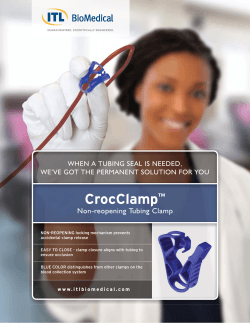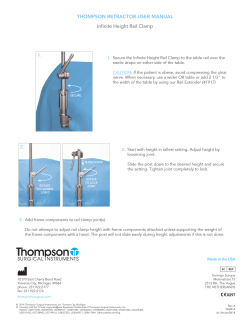
Fitters Guide
Fabric Expansion Joints Guide to Correct Handling and Installation Guide 440/1 Identification Number as to the accuracy, relevancy, appropriateness, currency or completeness of the date and information contained herein. It Fitters’ Guide to correct handling and installation of fabric expansion joints is solely provided “as is”. Further, ESA, FSA and constituent members exclude all direct, indirect, incidental, consequential The Fitters’ Guide provides guidance to engineers and fitters ESA. FSA. or any constituent members make no guarantee or punitive damages, whether foreseeable or not, and whether they were known or not. European Sealing Association Tegfryn, Tregarth, Gwynedd, LL57 4PL, United Kingdom Phone: +44 1248 600 250 Fax +44 1248 600 250 www.europeansealing.com Fluid Sealing Association 994 Old Eagle School Road – Suite 1019 Wayne, PA 19087-1802, United States of America Phone: 610-971-4850 Fax 610-971-4859 www.fluidsealing.com to ensure successful installation of fabric expansion joints. It is intended to complement other plant-approved installation and safety procedures. If in doubt, please refer to your supervisor. This Fitters’ Guide is an extract from the ESA+RAL+FSA Fabric Expansion Joints – Installation Guide (Publication no. 015). Please refer to this document for more details. In particular, please ensure that the pre-installation checks in the Installation Guide have been carried out and confirmed by your supervisor. ESA and FSA Expansion Joint Division Members may have special tooling, procedures and experience which may modify the installation procedure. For an explanation of terms used in this Fitters’ Guide, including details of packaging, transport, storage, health and safety, please refer to the ESA Expansion Joints - Engineering Guide (ESA Publication no. 011). Please read through this Fitters’ Guide entirely before starting installation and ask your supervisor if in doubt! Copyright 2010 No duplication without the prior written consent of the European Sealing Association or the Fluid Sealing Association Tools required Appropriate personal protection equipment Handling All materials MUST be kept dry prior to and during installation Place expansion joint (and cavity insulation or bolster, if applicable) on a supporting base, fitted with attachment points for the lifting equipment Spanner or wrench Calibrated torque wrench Measuring tape Hand-held drill G-clamps Adequate lifting equipment Never use hooks in bolt holes to lift the expansion joint or bolster Scissors or Stanley® knife (if required) Lubricant for fasteners / bolts Manufacturer’s joining kit (if joint is supplied open-ended) Other plant-specified equipment Use adequate manpower to avoid dragging along the floor Installation 1 During installation, never walk on, or damage expansion joints. 2 Organise the clamp bars to ensure correct match to duct flange. 4 the expansion joint slightly and slide 5 Compress between the gap in the duct. Orientate the joint to the ducting and locate the corners (if applicable), ensuring that the hot face is towards the inside of the duct. Pull the expansion joint over the duct flanges, spreading it equally to avoid any build up of excess material around the circumference of the duct. Secure with g-clamps. 6 3 If appropriate, apply lubricant uniformly to all thread, nut and washer load-bearing surfaces. Starting from one corner, position the expansion joint flange and 1 corner section of clamp bar correctly, ensuring that the rounded edges face inwards and towards the flange they are clamping. Compress the expansion joint with a g-clamp either side of the middle hole of the corner clamp bar section, so that If appropriate, support the weight of the expansion joint during installation. For a vertical duct, support the joint on the upper flange with g-clamps. the clamp bar holes line up with those in the duct flange (see following diagram). 7 Starting at the middle hole of the corner clamp bar section, drill one hole through the expansion joint material, using the clamp bar and duct flange as templates. It is very important that the g-clamps (on both sides of the hole) hold the material securely otherwise the fabric may rotate with the drill, resulting in tearing. Insert the bolt from the clamp bar side and tighten loosely. Working along the clamp bar, drill through the flange and clamp bar, inserting bolts from the clamp bar side and tightening the bolts loosely as you go, until all the bolts are in place in the first corner clamp bar section. Ensure that the edge of the expansion joint is level with the edge of the clamp bar or protruding slightly beyond. 8 In the same way, install the equivalent corner clamp bar section loosely on the opposite duct flange. 9 Install all other corners in a similar manner on both flanges. from the corners, use the same process to install 10 Starting all remaining clamp bar sections loosely, ensuring even distribution of excess expansion joint material (see following diagram). 12 Tighten bolts on both flanges to ~80% of final loading. 13 11 Adjust positioning of the clamp bars to ensure best fit and maximum gap of 3mm or 1/8 inch between adjacent clamp bars. Avoid pinching the expansion joint fabric (see following diagram). Using a torque wrench, tighten bolts to final loading. 14 Make a second round of tightening to final loading. 15 Report to your supervisor that installation is complete. Notes Notes
© Copyright 2025









